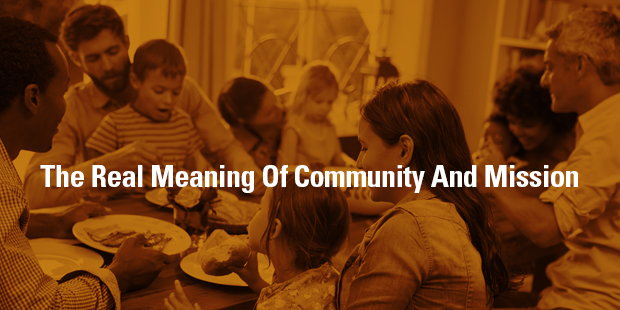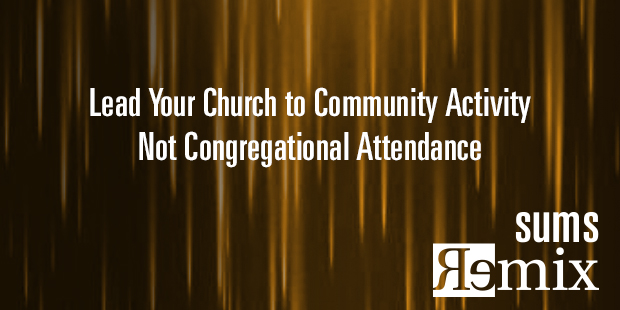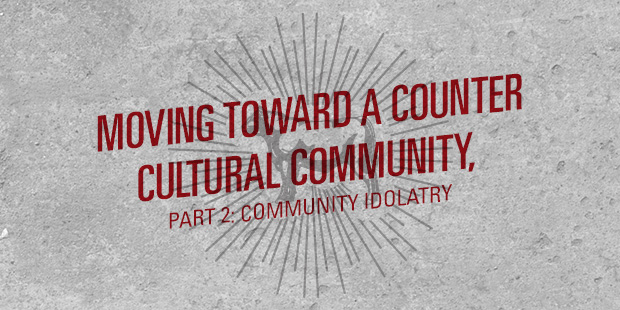Below is a new weekly series posting content from one of the most innovative content sources in the church world: SUMS Remix Book Summaries for church leaders. SUMS Remix takes a practical problem in the church and looks at it with three solutions; and each solution is taken from a different book. As a church leader you get to scan relevant books based on practical tools and solutions to real ministry problems, not just by the cover of the book. Each post will have the edition number which shows the year and what number it is in the overall sequence. (SUMS provides 26 issues per year, delivered every other week to your inbox).
Solution #3: Call the church to partner in missional, community activity not simply congregational, service attendance.
THE QUICK SUMMARY- Kingdom Come, by Reggie McNeal
There’s a reason Jesus taught us to pray, “Thy Kingdom come . . .” and not “Thy church come.”
The church clearly plays an important role in God’s plans. It was established by Christ, and He is its Head. But have we put too much emphasis on the church? Have we confused a means of participating in God’s Kingdom with the Kingdom itself?
In Kingdom Come, church ministry consultant Reggie McNeal reveals why it’s crucial to realign the church’s mission with God’s ultimate Kingdom agenda. You’ll discover how you can get in on―and help lead―the Kingdom movement currently underway.
Join the mission to help the Kingdom break into our hearts…and break out into the world.
A SIMPLE SOLUTION
While God’s mission in the world has not changed, in many churches today the idea of serving God has morphed into “becoming a good church member.” People are considered disciples based on their faithful support and participation in church activities, not necessarily on whether they are growing toward or reflecting the heart of Jesus for others and the world.
How do you remind people in your particular church culture that they are sent from God as missionaries everywhere, and every day? What words do you use to enlarge their imagination and ignite their heart for a redemptive mission focus?
Jesus did not establish the church to start a new religion called Christianity. He established the church as an expression of the Kingdom for the people of God as they partner with Him in His redemptive mission in the world.
Three critical shifts are necessary in order to synchronize the church’s story with the Kingdom.
We must recognize that God established the church to point to the Kingdom, not the other way around. We shouldn’t be trying to promote the church; we should be trying to raise awareness of the Kingdom. A Kingdom-focused approach would involve lots of listening and local input and would be conducted from a posture of quiet service rather than trying to send a “we’re here to bless you” message, which can seem self-serving.
A Kingdom-focused church operates from a conviction that God is already at work in the city. It would raise awareness that God wants the city to prosper and that, as God’s people, we want to help. God would be the star of the show, and His will that the Kingdom come on earth would be the main message.
We must acknowledge that the Kingdom, not the church, is the destination. The church is not the destination, and it’s not the point of the journey. It’s the life of the Kingdom that we’re trying to get to. That’s what people are after.
We need churches that are dedicated to the objective of helping people grow up in the faith, so they can live on mission in the world, to see their lives as a mission trip. If we rightly understand that the Kingdom is the destination, we will figure out ways to celebrate spiritual progress on the journey that leads people to full deployment as Kingdom agents.
We must realize that the Kingdom saga focuses primarily on the welfare of the community, not on the church. A Kingdom perspective means that the cues for authentic church celebration comes from the quality of life that people experience in the world, beyond the church.
Much of the time and energy and money we have put into developing our incredible church campuses and program offerings should have gone into improving our communities. I’m suggesting that we recalibrate our efforts and resources to reinvest in the welfare of our towns, cities, and neighborhoods.
– Reggie McNeal, Kingdom Come
A NEXT STEP
Schedule time with your team to prayerfully consider the degree of church-focus and Kingdom-focus each ministry or program of your church might have. It is recommended that you break this important discussion down into a series of three 75-minute action-oriented discussion sessions over three weeks.
Session 1 – Actions to help recognize that God established the church to point to the Kingdom, not the other way around
Church leaders whose priority is to build the church are not functioning in proper alignment with the mission of God. At the first of this series of team meetings, list your church’s major activities on the left side of a chart tablet. At the top of the chart, create two columns, entitling them “Church-Focused” and “Kingdom-Focused.” As a team, read down the list and agree on which column the activity falls under, placing an X in that column.
After completing the entire list, spend time brainstorming specific actions that would help move the activity from the church-focused column to the Kingdom-focused column. If an activity cannot be moved into the Kingdom-focused column, discuss the future of that activity.
Following this session, assign an individual to lead a team to further develop the concepts and actions needed to move the activity into the Kingdom-focused column. Make sure each team reports regularly to the senior leadership team.
Session 2 – Actions to help acknowledge that the Kingdom, not the church, is the destination
Is it time for you to get outside more?
At your second team meeting in this series, brainstorm as a team ways each member can get beyond the four walls of your church. By connecting with and becoming involved with community events such as participating in a health club or coaching a sports team, you will be amazed at your discoveries.
Set aside culturally driven leadership impulses for a quick-fix solution, and take the long view of health. After a six-month season of team involvement in these types of activities, have each member bring their observations back to the team for discussion and action. The focus is on how you can rethink and redesign your current church ministry programs to reflect a Kingdom bias.
As you begin to develop ideas for potential implementation, assign a team member to lead each activity and report back to the team on its progress.
Session 3 – Actions to help realize that the Kingdom saga focuses primarily on the welfare of the community, not on the church
A Kingdom-centered narrative focuses on how to be the church in the world. Issues for Kingdom-leaders are fundamentally different from those leading the institutional church.
In order to help your team change the focus to the community, you will need collaborators to provide support, generate new ideas, and serve as a catalyst to help your church move forward.
At your final team meeting in this series, discuss ways to discover and invite other people who “get” the Kingdom focus. Begin the discussion by brainstorming what types of Kingdom agenda items resonate with community groups.
Start new conversations with community leaders who are connected with these types of activities. Invite them to speak to your team about the possibilities of working together.
As a team, agree on specific courses of action that will help your focus shift to the community and not your church. Be sure that every action has an identified leader and timeframe for moving forward.
Vibrant churches look after the interests of others – starting with their neighbors across the street and around the block. They are involved in community concerns by supporting, if not actually leading, initiatives.
Thriving churches have open doors – open to each and every segment of their community.
To learn more about being involved in your community, start a conversation with the Auxano team today.
Taken from SUMS Remix 21-3, published August 2015
>> Subscribe to SUMS Remix <<

Tags: Community, Community activity, Kingdom Come, Reggie McNeal, SUMS Remix
|
What is MyVisionRoom? > | Back to Vision >































